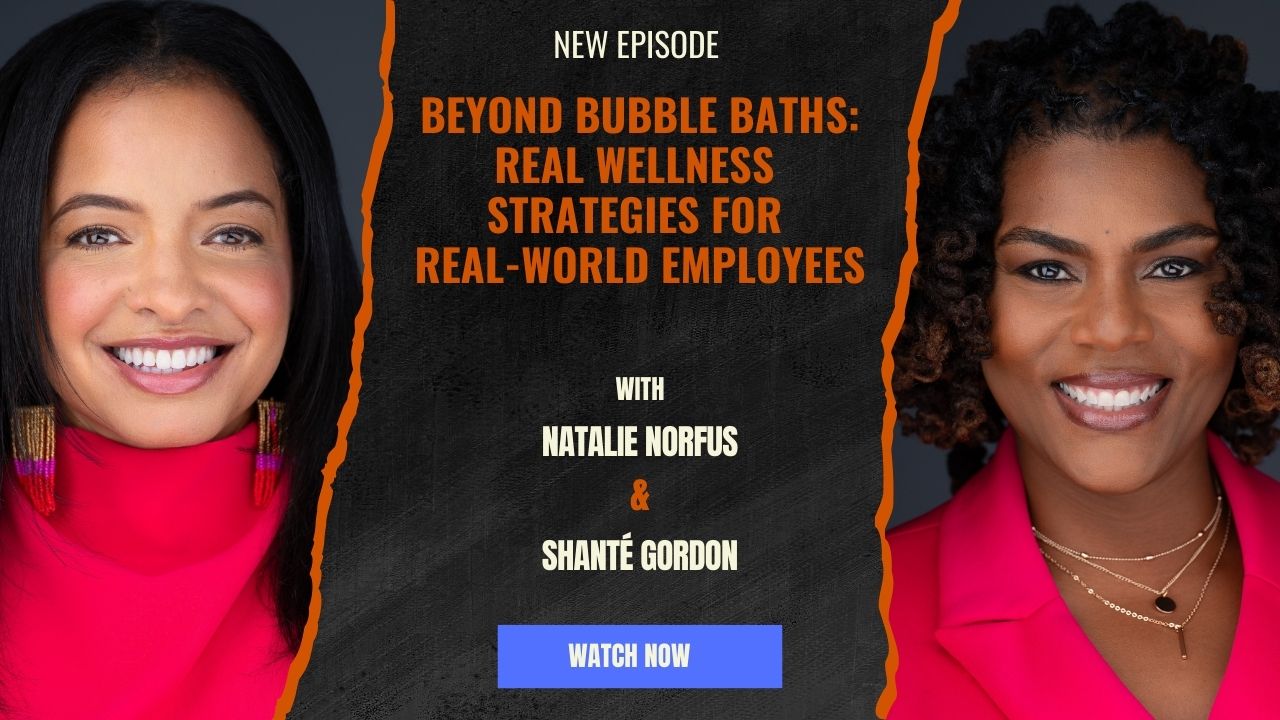Beyond Bubble Baths: Real Wellness Strategies for Real-World Employees

Let’s get one thing straight: wellness at work is not a lavender-scented bath bomb or a pop-up yoga class in the breakroom.
Sure, those things might feel nice for a moment, but in 2025—amid rolling layoffs, a constant barrage of political and social unrest, and chronic overstimulation—employees need more than feel-good gestures. They need employers who understand the new world we’re all living in and are willing to reimagine wellness in a way that actually makes life at work better.
In the latest episode of What’s the DEIL? hosts Natalie and Shanté examine what it really means to support employee well-being in an increasingly chaotic workplace and what companies can do to get it right.
Why Wellness Can’t Be Window Dressing
A stat from Harvard Business Review stopped us in our tracks: “Workers experiencing chronic stress or trauma may see up to a 35% drop in productivity.”
That means if you have 100 people working for you, the equivalent of 35 of them may not be able to perform at full capacity, every single day, simply because they’re emotionally exhausted.
And if we’re being honest, who isn’t emotionally exhausted right now?
Why Past Approaches Don’t Work Anymore
Between 2020 and 2023, wellness programs became buzzy and trendy—but also wildly ineffective. Many employers tried to “do the right thing” but failed to build anything sustainable or strategic. Instead, they resorted to:
- Drop-in webinars on burnout
- Once-a-month guided meditations
- Discounted gym memberships
- A Slack channel for “wellness talk” that no one used
- And yes, the infamous bubble bath content on Instagram
These tactics often felt performative and disjointed. Employees noticed, and trust eroded as a result.
“Don’t ask your people what they need if you’re not going to do anything about it.”
That’s been our mantra for years and holds more weight than ever in 2025.
The Reframe: From Tactics to Strategy
Wellness at work isn’t a perk. It’s a strategy.
And it needs to be treated with the same seriousness you’d give to sales goals, compliance policies, or tech stacks.
That starts by asking a critical question:
What do people need in order to do their best work in this environment, right now?
Spoiler: it’s not a new smoothie bar in the break room.
What Real Wellness Looks Like in 2025
Let’s break it down. The modern workplace is fast-paced, hyper-connected, and emotionally taxing. Employees don’t need you to “fix their lives.” They need you to create conditions where they can focus, contribute, and breathe.
Here are three wellness truths every employer should anchor into:
1. Psychological Safety Is the Foundation
This isn’t just a DEI buzzword. Psychological safety means employees feel:
- Safe to share ideas without fear of ridicule
- Able to make mistakes without punishment
- Supported when speaking up about concerns
But this doesn’t magically happen. It’s cultivated through consistency, trust-building, and (here’s the big one) clear expectations. Employers must do the work to clarify:
- What’s acceptable behavior in the workplace
- What topics can be discussed and how
- What employees can expect when they raise concerns
“You can’t say you care about wellness while keeping people in a constant state of fear.”
2. Workload Matters More Than Wellness Days
Want to help your people feel better? Stop overloading them.
We’re hearing it everywhere: “They laid off a third of the team and gave the rest of us triple the work.”
That’s not a strategy. That’s a recipe for burnout and disengagement. Wellness isn’t about offering more benefits. It’s about creating realistic, humane work environments.
Ask yourself:
- Are we prioritizing effectively?
- Are people working toward three core goals—or twenty?
- Are we rewarding productivity or just visible busyness?
Wellness starts with managing the actual work.
3. Transparency > Tactics
Most people can handle bad news. What they can’t handle is being blindsided.
In an era where layoffs are frequent and change is constant, transparency isn’t optional—it’s a trust-builder.
If layoffs may happen, say that early and clearly. If you’re testing new wellness initiatives, be honest about the process. If a program is underperforming, invite feedback before canceling it.
Employees don’t need perfection. They need clarity.
What Employers Can Stop Doing
As you’re refining your wellness strategy, here’s what you can retire in 2025:
- Vague employee surveys you never follow up on
- One-size-fits-all wellness programs
- Guest speakers without context or follow-through
- Inconsistent messaging about work-life balance
- Programs with unclear outcomes or hidden agendas
Instead, focus on meaningful consistency.
The 2-Lane Framework for Workplace Wellness
Shanté and Natalie break it down like this:
Wellness at work today lives in two core lanes.
- Building Trust and Psychological Safety
- Transparent leadership
- Clear norms and behavior standards
- Welcoming (not performative) inclusion practices
- Managing Workload and Focus
- Defined goals and priorities
- Reasonable expectations around output
- Grace for people to disconnect and recover
That’s it. Stick to these two lanes. Do them well. Repeat.
Start Here: Questions Every Employer Should Ask
If you’re serious about rethinking wellness, ask your team:
- Do you feel clear about what’s most important in your role?
- Do you feel safe speaking up about challenges?
- Is your workload manageable?
- Do you know what support is available to you?
- How well do we follow through on what we say we’ll do?
Use these questions in team meetings, one-on-ones, or pulse surveys—but only if you’re prepared to act on the feedback.
Final Word: Clarity Is Care
The future of wellness isn’t about doing more. It’s about doing what matters.
When you focus on creating clarity, reducing unnecessary stress, and building true psychological safety, your team doesn’t just feel better—they perform better, stay longer, and trust you more deeply.
As Shanté puts it, “Wellness isn’t a bonus. It’s a people strategy.”
Connect With Us
If you found this discussion compelling, we invite you to connect with us further. Here are some ways to stay in touch:
- Follow Natalie Norfus on LinkedIn
- Follow Shanté Gordon on LinkedIn
- Book a consultation with The Norfus Firm
- Follow What’s the DEIL on Instagram and TikTok
